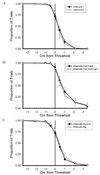Perceiving affordances for fitting through apertures
- PMID: 19045989
- PMCID: PMC2660607
- DOI: 10.1037/a0011393
Perceiving affordances for fitting through apertures
Abstract
Affordances--possibilities for action--are constrained by the match between actors and their environments. For motor decisions to be adaptive, affordances must be detected accurately. Three experiments examined the correspondence between motor decisions and affordances as participants reached through apertures of varying size. A psychophysical procedure was used to estimate an affordance threshold for each participant (smallest aperture they could fit their hand through on 50% of trials), and motor decisions were assessed relative to affordance thresholds. Experiment 1 showed that participants scale motor decisions to hand size, and motor decisions and affordance thresholds are reliable over two blocked protocols. Experiment 2 examined the effects of habitual practice: Motor decisions were equally accurate when reaching with the more practiced dominant hand and less practiced nondominant hand. Experiment 3 showed that participants recalibrate motor decisions to take changing body dimensions into account: Motor decisions while wearing a hand-enlarging prosthesis were similar to motor decisions without the prosthesis when data were normalized to affordance thresholds. Across experiments, errors in decisions to reach through too-small apertures were likely due to low penalty for error.
Figures









References
-
- Adolph KE, Avolio AM. Walking infants adapt locomotion to changing body dimensions. Journal of Experimental Psychology: Human Perception and Performance. 2000;26:1148–1166. - PubMed
-
- Adolph KE, Berger SA. Motor development. In: Kuhn D, Siegler RS, editors. Handbook of child psychology: Vol. 2:Cognition, Perception, and Language. 6th ed. New York: John Wiley & Sons; 2006.
-
- Berger JO. Statistical decision theory and Bayesian analysis. New York: Springer; 1985.
-
- Buekers M, Montagne G, de Rugy A, Laurent M. The regulation of externally paced human locomotion in virtual reality. Neuroscience Letters. 1999;275(3):171–174. - PubMed
-
- Bush S, Martin TA. Intermanual differences on the Rey Complex Figure Test. Rehabilitation Psychology. 2004;49(1):76–78.

